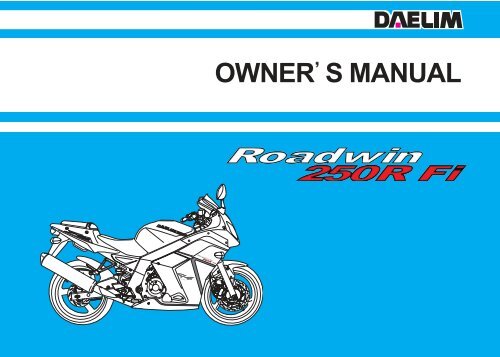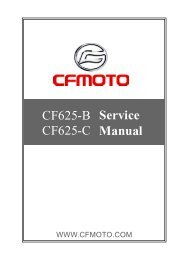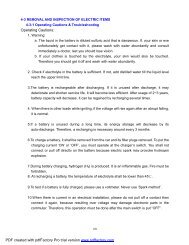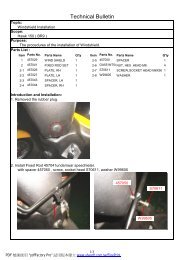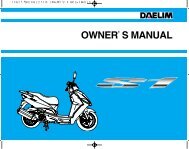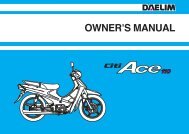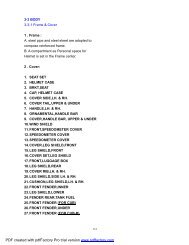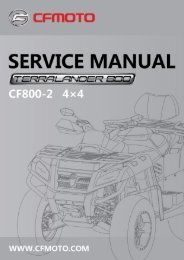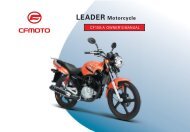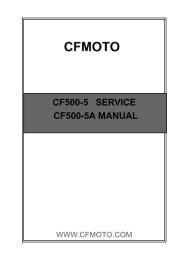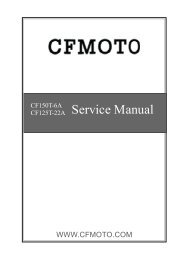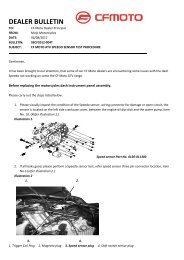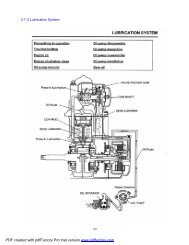Daelim VJF250 Owners Manual - Mojo
Daelim VJF250 Owners Manual - Mojo
Daelim VJF250 Owners Manual - Mojo
You also want an ePaper? Increase the reach of your titles
YUMPU automatically turns print PDFs into web optimized ePapers that Google loves.
OWNER S MANUAL
IMPORTANT NOTICE<br />
WELCOME<br />
Thank you for purchasing an <strong>Daelim</strong> vehicle. We hope you enjoy safe riding.<br />
OPERATOR AND PASSENGER<br />
This motorcycle is designed to carry the operator and one passenger.<br />
WARNING<br />
Attempting to change the pre-set maximum speed may cause danger and will void the <strong>Daelim</strong> warranty.<br />
ON-ROAD USE<br />
This motorcycle is designed to be used only on the road.<br />
READ THIS OWNER'S MANUAL CAREFULLY<br />
Pay special attention to statements preceded by the following words:<br />
WARNING<br />
Indicates a strong possibility of severe personal injury or death if instructions are not followed.<br />
CAUTION<br />
Indicates a possibility of personal injury or equipment damage if instructions are not followed.<br />
NOTE<br />
Gives helpful information.<br />
This manual is an important and integral part of your vehicle. keep it with your vehicle at all times, even though your vehicle is resold.
CONTENTS<br />
SPECIFICATION ...................................................................... 3<br />
OPERATION INSTRUCTION .............................................. 4<br />
SAFETY PRECAUTIONS .................................................. 4<br />
PRIOR TO STARTING VEHICLE ........................................ 5<br />
CORRECT ATTIRE ............................................................. 5<br />
OPERATION ........................................................................ 6<br />
CARGO ................................................................................ 7<br />
MODIFICATION ................................................................... 8<br />
ATTACHMENT .................................................................... 8<br />
MUFFLER ............................................................................ 8<br />
PARTS LOCATION .............................................................. 9<br />
METER READING AND USAGE ................................... 12<br />
METER .............................................................................. 13<br />
TACHOMETER .................................................................. 13<br />
FUEL GAUGE .................................................................... 13<br />
INDICATOR LAMPS .......................................................... 13<br />
MALFUNCTION INDICATOR LAMPS ............................... 13<br />
SWITCH OPERATION ...................................................... 14<br />
MAIN SWITCH .................................................................... 14<br />
KEYS ................................................................................. 15<br />
HEADLIGHT ...................................................................... 15<br />
STARTER BUTTON .......................................................... 16<br />
WINKER SWITCH ............................................................. 16<br />
HORN BUTTON ................................................................. 16<br />
EQUIPMENT USAGE ........................................................ 17<br />
STEERING LOCK .............................................................. 17<br />
SEAT .................................................................................. 17<br />
HELMET HOLDER ............................................................ 18<br />
STORAGE COMPARTMENT ............................................ 18<br />
BRAKE LEVER ADJUSTER .............................................. 18<br />
SELF INSPECTIONS BEFORE OPERATION .......... 19<br />
BRAKES ............................................................................ 19<br />
TIRES ................................................................................ 21<br />
CLUTCH ............................................................................ 23<br />
FUEL .................................................................................. 24<br />
ENGINE OIL ...................................................................... 25<br />
LIGHTS AND WINKER ...................................................... 25<br />
REAR VIEW MIRROR ...................................................... 26<br />
LICENSE PLATE ............................................................... 26<br />
OPERATION ........................................................................ 26<br />
PRE-RIDE INSPECTION ................................................... 26<br />
STARTING THE ENGINE .................................................. 27<br />
IF ENGINE CANNOT BE STARTED ................................. 28<br />
RUNNING-IN ..................................................................... 28<br />
RIDING .............................................................................. 29<br />
BRAKING ........................................................................... 30<br />
PARKING ........................................................................... 30<br />
1
MAINTENANCE .................................................................. 31<br />
MAINTENANCE SCHEDULE ............................................ 32<br />
TOOL KIT ........................................................................... 34<br />
FRAME NUMBER, ENGINE NUMBER .............................. 34<br />
VIN PLATE LOCATION ..................................................... 34<br />
MAINTENANCE PRECAUTIONS ...................................... 35<br />
THROTTLE OPERATION .................................................. 35<br />
AIR CLEANER ................................................................... 36<br />
ENGINE OIL ...................................................................... 37<br />
SPARK PLUG .................................................................... 38<br />
DRIVE CHAIN .................................................................... 39<br />
BRAKE PAD WEAR ........................................................... 41<br />
SIDE STAND ..................................................................... 42<br />
BATTERY .......................................................................... 42<br />
FUSE REPLACEMENT ..................................................... 44<br />
BULB REPLACEMENT ...................................................... 46<br />
CABLE RUBBER PART ..................................................... 49<br />
CLEANING ......................................................................... 49<br />
STORAGE GUIDE ............................................................. 50<br />
SAFE DRIVING ....................................................................... 51<br />
PREPARATION BEFORE DRIVING ............................ 51<br />
DRIVING METHOD ............................................................ 52<br />
DRIVING POSITION ........................................................... 52<br />
PRECAUTION WHEN DRIVING ....................................... 53<br />
STARTING ......................................................................... 54<br />
TURNING METHOD .......................................................... 55<br />
PRINCIPLE OF TURN ....................................................... 55<br />
EFFECT OF SPEED .......................................................... 55<br />
3 POSITIONS OF TURNING ............................................. 56<br />
TURNING METHOD .......................................................... 57<br />
PRECAUTION WHEN TURNING ...................................... 58<br />
BRAKING METHOD .......................................................... 59<br />
BASIC PRINCIPLE OF BRAKE(FRICTION FORCE) ........ 59<br />
RESTRAINT OF BRAKE EFFECT (INERTIA) .................. 59<br />
BRAKING METHOD .......................................................... 60<br />
COMPARISION OF BRAKING DISTANCE ........................ 60<br />
IMPACT WHEN COLLISION .............................................. 60<br />
WIRING DIAGRAM ............................................................... 62<br />
2
SPECIFICATION<br />
ITEM DATA ITEM DATA<br />
LENGTH×WIDTH×HEIGHT(mm)<br />
2,025×778×1,180<br />
IGNITION SYSTEM<br />
TRANSISTOR (ECU)<br />
WHEEL BASE(mm)<br />
1,390<br />
BATTERY CAPACITY<br />
12V10AH(MF TYPE)<br />
GROUND CLEARANCE(mm)<br />
139<br />
FUEL CAPACITY(l)<br />
15<br />
SEAT HEIGHT(mm)<br />
780<br />
RESERVE FUEL CAPACITY(l)<br />
4<br />
DRY WEIGHT(kg)<br />
PASSENGER<br />
173<br />
2<br />
TIRE SIZE<br />
FR.<br />
RR.<br />
110/70-17 54S<br />
140/60-17 69S<br />
ENGINE TYPE<br />
WATER COOLED<br />
4 STROKE, DOHC<br />
SUSPENSION<br />
FR.<br />
RR.<br />
TELESCOPIC<br />
SWING ARM<br />
PISTON DISPLACEMENT(cc)<br />
BORE AND STROKE(mm)<br />
247<br />
73×59<br />
BRAKE<br />
FR.<br />
RR.<br />
HYDRAULIC DISK<br />
HYDRAULIC DISK<br />
STARTING SYSTEM<br />
START MOTOR<br />
SPARK PLUG<br />
CR9EH-9<br />
TRANSMISSION TYPE<br />
5 STEPS RETURN<br />
FUSE(A)<br />
30 , 15<br />
3
OPERATION INSTRUCTION<br />
This manual describes matters pertaining to correct operation,<br />
safe operation and simple maintenance of the vehicle you<br />
purchased.<br />
To ensure more comfortable and safer operation,<br />
make sure to read this manual carefully prior to operation.<br />
● The photographs and drawings shown in this manual may<br />
differ from those of actual vehicles due to changes in vehicle<br />
specifications and modifications made.<br />
● This vehicle is designed for 2 riders including the operator.<br />
● Do not use polluted gasoline.<br />
Otherwse it cause rust inside the fuel tank, and<br />
close the suppiy of fuel to the injector, leading to<br />
an improper engine starting or may cause serious<br />
damage to engine.<br />
● Do use genuine oil, then it will protect and extend<br />
vehicle life.<br />
● Warranty does not apply to the motorcycles used in<br />
competitions or competitive trials. No motorcycle<br />
part may be tampered with, altered, or replaced with<br />
parts other than original <strong>Daelim</strong> spare parts during the<br />
warranty period.<br />
● As far as any defect caused by contaminated gasoline<br />
or oil, the warranty will be automatically invalidated.<br />
SAFETY PRECAUTIONS<br />
● Careful driving and the wearing of proper attire and safety<br />
equipment are the most important factors in the safe<br />
operation of the daystar. Please obey traffic regulations and<br />
do not be hurried and careless.<br />
● Many new vehicle owners operate their newly purchased<br />
vehicles with great care and attention to safety factors.<br />
However, after becoming accustomed to the operations are<br />
often discarded, which can lead to accidents. Please don't let<br />
this happen to you and always approach the operation of your<br />
vehicle with the safety considerations needed.<br />
When operating the vehicle, always keep in mind and obey<br />
the notes of precaution printed on the “Safety Precaution<br />
Label”attached to the vehicle.<br />
● Be sure to wear helmet at all time.<br />
● Be sure to put on gloves at all time.<br />
● Observe the speed regulations.<br />
● Beware of muffler affer driving as it is still hot to be burnt.<br />
Especially never children touch on it.<br />
● For safety, do not change, alteration or modification the<br />
vehicle.<br />
● Regularly conduct specified maintenance inspections.<br />
<br />
Brakes, Tires, Oil, Lights, Horn, Instruments<br />
4
PRIOR TO STARTING VEHICLE<br />
CORRECT ATTIRE<br />
● Read user's manual carefully.<br />
● Conduct maintenance checks prior to operation.<br />
● Always maintain vehicle in clean status and carry out<br />
specified maintenance checks.<br />
● Make sure to stop engine and stay away from fire when<br />
fueling.<br />
● Exhaust gas contains harmful substance such as carbon<br />
monoxide, Start engine in well-ventilated places.<br />
● Be sure you and your passenger always wear a helmet,<br />
eye pretection and other protective apparel when you<br />
ride.<br />
● Not wearing a helmet increases the chance of serious<br />
injury or death in a crash.<br />
5
OPERATION<br />
● Operators should naturally fix bodies to keep smooth driving.<br />
● Please check whether or not you are unnaturally strained and<br />
strung up.<br />
● Driving pose has a great influence on safe operation.<br />
Please always maintain the center of your body in the middle<br />
of seat. Especially do not sit at the rear seat because it may<br />
lessen the weight of front wheel and cause trembling steering<br />
wheel.<br />
● When wanting to turn, slightly lean to body toward the<br />
direction of the turn. It is unsafe if the body is not moved<br />
in union with the motorcycle.<br />
● Curvy roads and poor, unpaved roads constantly change in<br />
surface quality. Driving on these roads can be unsafe if<br />
certain safety precautions are not followed.<br />
● In order to safely drive through these driving conditions,<br />
anticipate coming road conditions, slow down to at least half<br />
the normal speed, and relax your shoulders and wrists while<br />
securely holding the handles.<br />
<br />
● Always hold the handle bars firmly with both hands<br />
whiling driving, otherwise, it cause severe injury or death<br />
of the driver. The pillion passenger should always hold<br />
on to the operator with both hands and keep both feet on<br />
the pillion step bar. otherwise, it cause severe injury or<br />
death.<br />
6
●<br />
●<br />
●<br />
●<br />
● Pay attention not to overload goods and fasten it tightly<br />
whiling driving.<br />
● Do not place kind of cloth materials nearby oil tank cap.<br />
If the hole in oil tank cap is clogged, oil will not flow freely<br />
into the engine which can cause severely engine damage.<br />
● Do not attach large or heavy items (such as a sleeping bag<br />
or tent) to the handle bars, fork, or fender. Unstable<br />
handling or sliw steering response may result.<br />
7
MODIFICATION<br />
● Modification of vehicle structure or function deteriorates<br />
manipulatability or causes exhaust noise to become louder<br />
shortening the vehicle life. These modifications are not only<br />
prohibited by law but also are the acts harmful to other<br />
people. Modifications are not covered by warranty.<br />
● As far as any defect caused by modifications, the<br />
warranty will be automatically invalidated.<br />
MUFFLER<br />
Pay particular attention to fellow passenger so that he/she<br />
can prevent getting burnt by the hot muffler during travel.<br />
●<br />
● Improper accessories or modifications can cavse a crash<br />
in which you can be seriously hurt or killed.<br />
● Follow all instruction in this owneris manual regarding<br />
accessories and modifications.<br />
ATTACHMENT<br />
●<br />
Except designated attachment by DAELIM MOTOR CO.LTD.,<br />
don’t attach any extra lighting device, because it may cause an<br />
early discharging of battery.<br />
●<br />
Carefully inspect the accessory to make sure it does not obscure<br />
any lights, reduce ground clearance and banking angle, or limit<br />
suspension travel, steering travel or control operation.<br />
● Do not add electrical equipment that will exceed the motorcycle’s<br />
electrical system capacity. A blown fuse could cause a dangerous<br />
loss of lights or engine power.<br />
●<br />
This motorcycle was not designed to pull a sidecar or trailer.<br />
Handling may be seriously impaired if so equipped.<br />
● Beware of muffler after driving as it is still hot to be<br />
burnt. Especially never children touch on it. And pay<br />
attention to park where pedestrian zoon.<br />
● If haystack or vinyl is stuck to the muffler, it might be<br />
fired.<br />
8
PARTS LOCATION<br />
TACHOMETER<br />
LCD SPEEDOMETER<br />
ENGINE COOLANT<br />
TEMPERATURE<br />
GAUGE<br />
CLOCK<br />
REAR VIEW MIRROR<br />
PASSING SWITCH<br />
CLUTCH LEVER<br />
FUEL GAUGE<br />
FRONT BRAKE FLUID<br />
RESERVOIR<br />
HEADLIGHT SWITCH<br />
FRONT BRAKE LEVER<br />
THROTTLE GRIP<br />
HEADLIGHT<br />
DIMMER SWITCH<br />
WINKER SWITCH<br />
STARTER BUTTON<br />
MAIN SWITCH<br />
HORN BUTTON<br />
FUEL FILLER CAP<br />
9
PARTS LOCATION<br />
FUEL TANK<br />
PILLION SEAT<br />
MAIN SEAT<br />
TAIL LIGHT<br />
REAR WINKER<br />
(TURN SIGNAL)<br />
FRONT WINKER<br />
(TURN SIGNAL)<br />
FRONT TIRE<br />
MUFFLER<br />
REAR TIRE<br />
PILLION STEP BAR<br />
REAR DISK BRAKE<br />
REAR BRAKE FLUID<br />
RESERVOIR<br />
RH. CRANK CASE COVER<br />
COOLANT RESERVOIR<br />
10
PARTS LOCATION<br />
REAR VIEW MIRROR<br />
CLUTCH LEVER<br />
HEAD LIGHT<br />
FRONT FENDER<br />
REAR WINKER<br />
(TURN SIGNAL)<br />
HELMET HOLDER<br />
(SEAT LOCK)<br />
REAR CUSHION<br />
DRIVE CHAIN<br />
FRONT BRAKE DISK<br />
FRONT COWL<br />
SIDE STAND<br />
MAIN STAND<br />
11
METER READING AND USAGE<br />
HEAD LIGHT HIGH-BEAM<br />
INDICATOR<br />
WINKER INDICATOR<br />
SPEEDO METER<br />
TACHOMETER<br />
CLOCK<br />
ENGINE COOLANT<br />
TEMPERATURE<br />
GAUGE<br />
FUEL GAUGE<br />
ODO&TRIP<br />
INDICATOR<br />
12<br />
MIL INDICATOR<br />
NEUTRAL<br />
INDICATOR<br />
MODE BUTTON<br />
ADJ BUTTON
● Running the engine beyond recommended<br />
maximum engine speed(the beginning of<br />
the tachometer red zone)can damage the<br />
engine.<br />
Indicates amount of gasoline in fuel tank.<br />
If needle is within E mark,immediately fill<br />
gasoline. Balance at this time is<br />
approximately 4.0 litres.<br />
● To avoid running out of fuel,it might cause<br />
serve injury due to engine abruptly stop.<br />
<br />
Press the mode button for 2~3 seconds<br />
(flickering) then adjust time using mode<br />
button and ADJ button.<br />
MIL<br />
● EMS(Engine Management System)is<br />
equipped with a self-diagnosis function<br />
in order to ensure that the engine control<br />
system is operation normally.<br />
● If this function detects a malfunction in<br />
the system, the malfunction indicator<br />
lamp immediately operates. It gives the<br />
rider that malfunction has occurred in<br />
the system.<br />
● Normally, the malfunction indicator<br />
lamp illuminates for 3 seconds when the<br />
main key is turned on. If the malfunction<br />
indicator lamp does not come on under these<br />
conditions, the malfunction indicator lamp<br />
may be defective.<br />
● After 3 seconds, the malfunction indictor<br />
lamp off automatically. However, the<br />
MIL blinks continuously, check the EMS<br />
system. If you are not able to check the<br />
EMS system, contact your daelim dealers.<br />
● The EMS takes fail-safe function, it<br />
enables to drive only temporary by<br />
starting even on conditioned.<br />
13
SWITCH OPERATION<br />
● Do not operate main switch key during<br />
<br />
<br />
<br />
<br />
<br />
<br />
operation.<br />
● If the main switch key is placed on<br />
“Off”or“Lock”position, all electrical<br />
system will not function.<br />
● Never operate the main switch key<br />
during travel as it might cause<br />
unexpected accidents.<br />
● If it is necessary to remove the main<br />
switch key, stop the vehicle first prior to<br />
removing.<br />
● Prior to dismounting from the vehicle,<br />
make sure to lock the steering wheel<br />
and remove key.<br />
● If the key is left in “ON” position<br />
without starting engine, battery is<br />
discharged.<br />
● Do not use a number of keys together<br />
with a metal key holder.<br />
The keys and the key holder may<br />
cause scratches or other damage to<br />
the cover while operating the<br />
vehicle.(Recommend cloth or leather<br />
key holders)<br />
14
●<br />
<br />
●<br />
15
●<br />
●<br />
16
EQUIPMENT USAGE<br />
STEERING LOCK<br />
To lock the steering, turn the handlebars<br />
all the way to the left or right, turn the key<br />
to LOCK while pushing in.<br />
Remove the key.<br />
To unlock the steering, turn the key to<br />
OFF while pushing in.<br />
<br />
<br />
SEAT<br />
SEAT><br />
To remove the main seat, insert the<br />
ignition key into the seat lock.<br />
Turn the ignition key counterclockwise,<br />
and then pull the seat back and up.<br />
To install the main seat, insert the tab into<br />
the recess under the frame and push down<br />
on the rear of the seat.<br />
CENTER COVER<br />
<br />
1. Push the brake forward.<br />
2. Turn the adjuster and set up the most<br />
fitting location among numerals (1 to 4).<br />
3. Be sure that the numeral is align with an<br />
arrow, keep your hands off the brake<br />
lever, and confirm setting condition.<br />
HELMET HOLDER<br />
TOOL KIT<br />
<br />
BRAKE LEVER ADJUSTER<br />
<br />
<br />
●<br />
●<br />
( NORMAL ) ( ABNORMAL )<br />
BRAKE LEVER ADJUSTER<br />
● The brake lever adjuster is device<br />
regulating a space between the handle<br />
grip and the brake lever to brake easily.<br />
● If the numeral of the brake lever<br />
adjuster and an arrow are not fitting,<br />
The brake doesn’t work and it is may<br />
cause the occurrence of an accident.<br />
● If the free play of the brake lever is<br />
big or small. the brake doesn’t work<br />
normally and it is may cause the<br />
occurrence of an accident.<br />
18
SELF INSPECTIONS BEFORE OPERATION<br />
●<br />
●<br />
●<br />
●<br />
●<br />
●<br />
●<br />
●<br />
19
Check that the fluid level is above the<br />
LOWER level mark with the motercycle<br />
in an upright position.<br />
Brake fluid must be added to the reservoir<br />
whenever the fluid level begins to reach<br />
the LOWER level mark.<br />
<br />
<br />
<br />
<br />
<br />
<br />
1. Remove the screws and master cylinder<br />
cap, diaphragm plate, and diaphragm.<br />
2. Fill the reservoir with recommended<br />
brake fluid from a sealed container up<br />
to the UPPER level mark.<br />
RECOMMENDED BRAKE FLUID<br />
is DOT3<br />
3. Reinstall the diaphragm, diaphragm<br />
plate, and master cylinder cap.<br />
4. Tighten the screws securely.<br />
Other checks :<br />
Make sure there are no fluid leaks.<br />
Check for deterioration or cracks in the<br />
hose and fitting.<br />
Check the brake pad for wear when<br />
refilling with brake fluid.<br />
<br />
<br />
<br />
<br />
[REAR BRAKE]<br />
<br />
<br />
Lightly squeeze the brake pedal until<br />
tention is felt to check for an<br />
appropriate amount of free play. No<br />
free play in the brake pedal or overly<br />
loosen brake pedal is indication of a<br />
problem in the brake system.<br />
BRAKE PEDAL FREE PLAY :<br />
10 ~ 20 mm<br />
●<br />
●<br />
●<br />
●<br />
CAUTION<br />
When adding brake fluid, be very<br />
careful not to allow foreign materials<br />
to enter the reserve tank.<br />
Do not fill past upper level.<br />
This can cause brake fluid to leak out<br />
of the reserve tank.<br />
Do not let brake fluid contact vehicle<br />
parts as this damages painted areas.<br />
If oil contacts parts, quickly clean the<br />
fluid off using a dry cloth.<br />
Use recommended brake fluid as<br />
other types can undergo chemical<br />
changes.<br />
20
●<br />
●<br />
WARNING<br />
Brake fluid may cause irritation.<br />
Avoid contact with skin or eyes. In<br />
case of contact, flush thoroughly with<br />
water and call a doctor if your eyes<br />
were exposed.<br />
KEEP OUT OF REACH OF CHIL-<br />
DREN<br />
<br />
S<br />
S<br />
<br />
<br />
<br />
<br />
<br />
21
●<br />
<br />
<br />
●<br />
<br />
<br />
●<br />
<br />
<br />
<br />
<br />
<br />
<br />
22
CLUTCH<br />
Clutch adjustment may be reguired if the<br />
motorcycle stalls when shifting into gear<br />
or tends to creep; or if the clutch slips,<br />
causing acceleration to lag behind engine<br />
speed.<br />
Minor adjustments can be made with the<br />
clutch cable adjuster at the lever.<br />
CLUTCH LEVER FREE PLAY:10~20mm<br />
<br />
1. Loosen the lock nut and turn the<br />
adjuster. Tighten the lock nut and check<br />
the adjustment.<br />
2. If the adjuster is threaded out near its<br />
limit or if the correct free play cannot<br />
be obtained, loosen the lock nut and<br />
turn in the cable adjuster completely.<br />
Tighten the lock nut.<br />
<br />
<br />
<br />
4. Start the engine, pull in the clutch lever<br />
and shift into gear. Make sure the<br />
engine does not stall and the motorcycle<br />
does not creep. Gradually release the<br />
clutch lever and open the throttle.<br />
The motorcycle should begin to move<br />
smoothly and accelerate gradually.<br />
<br />
<br />
<br />
<br />
<br />
<br />
<br />
<br />
3. Loosen the lock nut at the lower end of<br />
the cable. Turn the adjusting nut to<br />
obtain the specified free play. Tighten<br />
the lock nut and check the adjustment.<br />
●<br />
NOTE<br />
If proper adjustment cannot be<br />
obtained or the clutch does not work<br />
correctly, see your <strong>Daelim</strong> dealer.<br />
23
FUEL<br />
<br />
The fuel tank capacity including the<br />
reserve supply is : 15<br />
To open the fuel fill cap;<br />
1. Insert the ignition key and turn it<br />
clockwise.<br />
2. The cap is hinged and will lift up.<br />
3. Do not overfill the tank. There should<br />
be no fuel in the filler neck.<br />
4. After refueling, to close the fuel fill<br />
cap, push the cap into the filler neck<br />
until it snaps closed and locks.<br />
5. Remove the key.<br />
<br />
<br />
●<br />
●<br />
●<br />
WARNING<br />
Gasoline is extremely flammable and<br />
is explosive under certain conditions.<br />
Refuel in a well-ventilated area with<br />
the engine stopped. Do not smoke or<br />
allow flames or sparks in the area<br />
where gasoline is stored or where the<br />
fuel tank is refueled.<br />
Do not overfill the tank. After<br />
refueling, make sure the fuel fill cap<br />
is closed securely.<br />
Avoid repeated or prolonged contact<br />
with skin or breathing of vapor.<br />
KEEP OUT OF REACH OF CHILDREN.<br />
<br />
<br />
24
ENGINE OIL<br />
<br />
Check the engine oil level each day before<br />
riding the motorcycle.<br />
The level must be maintained between the<br />
upper and lower level marks on the oil<br />
level gauge.<br />
1. Start the engine and let it idle for a few<br />
minutes.<br />
2. Stop the engine and put the motorcycle<br />
on its main stand on level ground.<br />
3. After a few minutes, remove the oil<br />
level gauge, wipe it clean, and reinsert<br />
the gauge without screwing it in.<br />
Remove the gauge. The oil level should<br />
be between the upper and lower marks<br />
on the oil level gauge.<br />
4. If required, add the specified oil up to<br />
the upper level mark.<br />
Do not overfill.<br />
5. Reinstall the oil level gauge.<br />
Check for oil leaks.<br />
●<br />
CAUTION<br />
Running the engine with insufficient<br />
oil pressure may cause serious engine<br />
damage.<br />
<br />
<br />
<br />
<br />
<br />
LIGHTS AND WINKER<br />
<br />
Start the engine and make sure the lights<br />
turn on. Also check to see if the lights are<br />
damaged or if there is dirt on them.<br />
<br />
Turn the main switch to ON.<br />
While separately operating the front and<br />
rear brakes, check to see if the brake light<br />
turns on. Also check to see if there is any<br />
damage to the lens or if there is dirt on the<br />
brake light.<br />
<br />
Turn the main switch to ON.<br />
Check to see if all the winker in the front<br />
and rear of the vehicle (including left and<br />
right sides) are flashing properly. At the<br />
same time, check to make sure that the<br />
automatic sound signal of the winker is<br />
working. Check also to see if any of the<br />
lens are damaged or dirty.<br />
25
26<br />
REAR VIEW MIRROR<br />
Sit squarely on the seat and check to see if<br />
you have a good view behind the vehicle<br />
by looking at the rear view mirrors. Also<br />
check for dirt and damage on the rear view<br />
mirrors.<br />
LICENSE PLATE<br />
Check to see if there is any dirt or damage<br />
to the license plate.<br />
Also check to see if the license plate is<br />
firmly secured to the vehicle.<br />
OPERATION<br />
PRE-RIDE INSPECTION<br />
●<br />
WARNING<br />
If the pre-ride inspection is not<br />
performed, severe personal injury or<br />
motorcycle damage may result.<br />
Inspect your motorcycle every day before<br />
you ride it. The items listed here will only<br />
take a few minutes to inspect, and in the<br />
long run they can save time, expense, and<br />
possibly your life.<br />
●<br />
Check for signs of abnormality which<br />
might have occurred on the previous<br />
day.<br />
●<br />
Engine oil level - add engine oil if<br />
required (page 25). Check for leaks.<br />
●<br />
Fuel level - fill fuel tank when necessary<br />
(page 24). Check for leaks.<br />
●<br />
Front and rear brakes - check operation;<br />
make sure that is no brake fluid leakage<br />
(page 19~21).<br />
●<br />
Tires - check condition and pressure<br />
(page 21~22).<br />
●<br />
Drive chain - check condition and slack<br />
(page 39~40). Adjust and lubricate if<br />
necessary.<br />
●<br />
●<br />
●<br />
●<br />
Throttle - check for smooth opening<br />
and full closing in all steering positions.<br />
Lights and horn - check that headlight,<br />
tail/brake light, turn signals, indicators<br />
and horn function properly.<br />
Side stand switch ignition cut-off<br />
system - check for proper function<br />
(page 42).<br />
Angle rear view mirror.<br />
●<br />
CAUTION<br />
Observe safety rules when conducting<br />
inspections.<br />
Conduct inspections on a flat, solid<br />
ground with the main stand erected.<br />
If you are unable to correct trouble even<br />
after you make adjustment or correction,<br />
contact authorized maintenance shops,<br />
dealers or designated repair shops for<br />
necessary inspection and repairs.
STARTING THE ENGINE<br />
Always follow the proper starting<br />
procedure described below.<br />
●<br />
This motorcycle is equipped with a side<br />
stand ignition cut-off system. The<br />
engine cannot be started if the side<br />
stand is down, unless the transmission<br />
is in neutral. If the side stand is up, the<br />
engine can be started in neutral or in<br />
gear with the clutch lever pulled in.<br />
After starting with the side stand down,<br />
the engine will shut off if the<br />
transmission is put in gear before<br />
raising the side stand.<br />
●<br />
●<br />
WARNING<br />
Never run the engine in an enclosed<br />
area. The exhaust contains poisonous<br />
carbon monoxide gas that can cause<br />
loss of consciousness and lead to<br />
death.<br />
CAUTION<br />
Do not keep the starter button<br />
pressed for more than 5 seconds at a<br />
time. Release the starter button for<br />
approximately 10 seconds before<br />
pressing it again.<br />
<br />
Before starting, insert the key, turn the<br />
ignition switch ON and confirm the<br />
following:<br />
●<br />
●<br />
●<br />
The transmission is in NEUTRAL<br />
(neutral indicator light ON)<br />
Check to see if the MIL is<br />
for 3 second.<br />
Check to see if the side stand is in pulled<br />
back.<br />
< ><br />
1. Close throttle grip, and press starter<br />
button.<br />
2. If engine is not started, Repeat "1".<br />
< ><br />
1. Close throttle grip and press starter<br />
button.<br />
2. If engine is not started with 1-2 times trial,<br />
open throttle grip approximately 1/8 to 1/4<br />
and press starter button.<br />
3. Once engine is started, pull and release<br />
throttle grip repeatedly to run engine idle<br />
until engine is heated.<br />
27
●<br />
It is possible that starting will be more<br />
difficult if the vehicle has not been used<br />
for a long period of time or if the fuel<br />
hole is plugged up (starting problems<br />
even when there is sufficient fuel in the<br />
fuel tank may be an indication of a<br />
plugged fuel hole).<br />
When this happens, do not rotate the<br />
throttle grip and try the starter button a<br />
few times.<br />
●<br />
NOTE<br />
Do not run engine idle unreasonably.<br />
This not only wastes fuel but also<br />
adversely affects engine.<br />
If starter button is pressed in gear<br />
position, vehicle may bring out to<br />
fall. Make sure gear is in neutral<br />
position prior to starting engine.<br />
IF ENGINE CANNOT BE STARTED<br />
If engine cannot be started or vehicle does<br />
not move, check the followings.<br />
●<br />
Is there fuel in fuel tank?<br />
●<br />
Are you operating in accordance with<br />
the instructions given in user's manual?<br />
●<br />
Is fuse not cut?<br />
●<br />
Is starter motor running?<br />
●<br />
If starter motor is not running due to<br />
battery consumption, charge the battery.<br />
●<br />
If the MIL blinks continously when the<br />
main key is on, inquiry to the daelim<br />
dealer.<br />
RUNNING-IN<br />
During initial running-in newly machined<br />
surfaces will be in contact with each other<br />
and these surfaces will wear in quickly.<br />
Running-in maintenance at 1,000km is<br />
designed to compensate for this initial<br />
minor wear.<br />
Timely performance of the running-in<br />
maintenance will ensure optimum service<br />
life and performance from the engine.<br />
The general rules as follows:<br />
1. Never labour the engine with full<br />
throttle at low engine speeds. This rule<br />
is applicable not only during running-in<br />
but at all times.<br />
2. Maximum continuous engine speed<br />
during the first 1,000km must not<br />
exceed 5,000 rpm.<br />
●<br />
CAUTION<br />
Running the engine beyond recommended<br />
maximum engine speed (the<br />
beginning of the tachometer red<br />
zone) can damage the engine.<br />
28
RIDING<br />
1. After the engine has been warmed up,<br />
the motorcycle is ready for riding.<br />
2. While the engine is idling, pull in the<br />
clutch lever and depress the gearshift<br />
pedal to shift into 1st (low) gear.<br />
3. Slowly release the clutch lever and at<br />
the same time gradually increase engine<br />
speed by opening the throttle. Coordination<br />
of the throttle and clutch lever<br />
will assure a smooth positive start.<br />
4. When the motorcycle attains a moderate<br />
speed, close the throttle, pull in the<br />
clutch lever and shift to 2nd gear by<br />
raising the gearshift pedal.<br />
This sequence is repeated to progressively<br />
shift to 3rd, 4th, 5th (top) gear.<br />
5. Coordinate the throttle and brakes for<br />
smooth deceleration.<br />
6. Both front and rear brakes should be<br />
used at the same time and should not be<br />
applied strongly enough to lock the<br />
wheel, or braking effectiveness will be<br />
reduced and control of the motorcycle<br />
be difficult.<br />
<br />
If you gear down when you need to<br />
drastically accelerate speed such as when<br />
you are passing another motorcycle, speed<br />
can be accelerated. If you ride too fast, it<br />
adversely affects engine because engine<br />
revolution is excessive.<br />
●<br />
2 3 4 5<br />
1<br />
<br />
CAUTION<br />
Touch pedal lightly with foot and<br />
shift gear perfectly until you hear<br />
"Click" at the pedal. If you apply<br />
excessive force when shifting gear,<br />
transmission may be damaged.<br />
●<br />
●<br />
●<br />
●<br />
●<br />
●<br />
NOTE<br />
Make sure side stand is in original<br />
position prior to starting motorcycle.<br />
If side stand moves unsatisfactorily,<br />
check lubrication state on side stand<br />
joint.<br />
Shift gear adequately according to<br />
vehicle speed.<br />
To save fuel and maintain optimum<br />
vehicle life, do not accelerate or<br />
decelerate speed abruptly.<br />
Always start in the 1" gear, and start<br />
carefully as slow as possible.<br />
If you hear abnormal noise during<br />
travel, contact authorized maintenance<br />
shop immediately for<br />
inspection and necessary action.<br />
Maintain legal speed limits.<br />
29
BRAKING<br />
1. For normal braking, gradually apply<br />
both the front and rear brakes while<br />
down shifting to suit your road speed.<br />
2. For maximum deceleration, close the<br />
throttle and apply the front and rear<br />
brakes firmly.<br />
WARNING<br />
●<br />
If you apply brakes only on front<br />
wheel or rear wheel, vehicle may<br />
slide off sideway and fall.<br />
If you apply brakes abruptly during<br />
travel in rain or on wet road, tires<br />
slide off and may cause accidents.<br />
Reduce speed and apply brake<br />
cautiously.<br />
Avoid repeated brake operation as it<br />
may cause brake temperature to rise,<br />
leading to braking effect deterioration.<br />
When possible, reduce speed or<br />
brake before entering a turn; closing<br />
the throttle or braking in mid-turn<br />
may cause wheel slip. Wheel slip<br />
will reduce control of the motorcycle.<br />
<br />
If you turn throttle grip in reverse, engine<br />
brake functions and, if you need stronger<br />
braking, shift gear down from 4th to 3rd<br />
and so forth. When you travel on a long<br />
descent or on a sharp descent, use<br />
intermittent braking technique and engine<br />
brake simultaneously.<br />
●<br />
CAUTION<br />
Do not shift to lower gear while<br />
traveling at an excessive speed as it<br />
may suddenly increase the engine<br />
speed, adversely affect the engine<br />
and transmission, and cause the rear<br />
part of the vehicle to be shaken.<br />
PARKING<br />
1. After stopping the vehicle, shift the<br />
transmission into neutral, turn the fuel<br />
cock OFF, turn the ignition switch OFF<br />
and remove the key.<br />
2. Put the vehicle on main stand and park<br />
on level ground in places free of traffic.<br />
3. Use the side stand to support the<br />
vehicle while parked.<br />
4. Turn the handlebar fully to the left and<br />
lock the steering to help prevent theft.<br />
●<br />
●<br />
●<br />
CAUTION<br />
Park the vehicle on firm, level ground<br />
to prevent it from falling over.<br />
Park in a safe area that will not block<br />
traffic. When you parked the vehicle<br />
after driving, make sure foot the<br />
vehicle beyond man's reach because<br />
engine and muffler are still hot.<br />
If you must park on a slight incline,<br />
aim the front of the vehicle uphill to<br />
reduce the possibility of rolling off the<br />
side stand or overturning.<br />
30
MAINTENANCE<br />
●<br />
●<br />
The Required Maintenance Schedule specifies how often you should have your motorcycle served, and what things need attention.<br />
It is essential that your motorcycle be served as scheduled to retain its high level of safety, dependability, and emission control<br />
performance.<br />
These instructions are based on the assumption that the motorcycle will be used exclusively for its designed purpose. Sustained high<br />
speed operation, or operation in unusually wet or dusty conditions, will require more frequent service than specified in the<br />
MAINTENANCE SCHEDULE.<br />
Consult your authorized <strong>Daelim</strong> dealer for recommendations applicable to your individual needs and use.<br />
31
32<br />
COOLANT CHECK
ITEM<br />
FREQUENCY ODOMETER READING(NOTE 1)<br />
1,000Km 1 4 8 12 16<br />
MONTH 1 6 12 18 24<br />
REMARK<br />
BRAKE FLUID I I I I R NOTE( 3)<br />
BRAKE SHOE / PAD WEAR I I I I I<br />
BRAKE SYSTEM I I I I I<br />
BRAKE STOP SWITCH I I I I I<br />
HEADLIGHT ADJUSTMENT I I I I I<br />
SUSPENSION I I<br />
CLUTCH I I I I I<br />
SIDE STAND I I I I<br />
BOLTS, NUTS, FASTENERS I I I<br />
WHEELS / TIRES I I I I I<br />
STEERING HANDLE BEARING I I I I I<br />
If you do not have the appropriate tools or information to conduct maintenance, or if you feel you are not capable to perform<br />
maintenance on this vehicle, inquiry to the authorized dealers or repair shops for maintenance and repairs.<br />
To ensure safety, inspections and maintenance of these parts must be carried out by dealers, or repair centers.<br />
NOTES : (1) At higher odometer readings, repeat at the frequency interval established here.<br />
(2) Service more frequently when riding in unusually wet or dusty areas.<br />
(3) Replace every 2 years, or at indicated odometer interval, whichever comes first. Replacement requires mechanical skill.<br />
33
●<br />
●<br />
FRAME NUMBER, , ENGINE NUMBER<br />
● The frame number, , engine number are<br />
needed when registering your motorcycle.<br />
● They may also be required by your<br />
dealer when ordering replacement parts.<br />
● Record the numbers here for your<br />
reference.<br />
VIN PLATE LOCATION<br />
Vin Plate is located on the pipe of RH.<br />
engine hanger under the radiator.<br />
●<br />
●<br />
●<br />
●<br />
<br />
<br />
● The frame number is stamped on the<br />
left side of the steering head.<br />
● The engine number is stamped on under<br />
of the left crankcase.<br />
DAELIM MOTOR CO., LTD.<br />
<br />
<br />
<br />
<br />
<br />
<br />
<br />
<br />
34
●<br />
●<br />
●<br />
●<br />
●<br />
●<br />
●<br />
●<br />
●<br />
●<br />
●<br />
●<br />
<br />
●<br />
●<br />
35
AIR CLEANER<br />
When the element becomes dirty, there<br />
will be greater intake resistance, resulting<br />
in decreased power output and increased<br />
fuel consumption.<br />
The air cleaner should be serviced at<br />
regular intervals (page 32).<br />
Service more frequently when riding in<br />
dusty areas.<br />
●<br />
●<br />
●<br />
CAUTION<br />
Do not operate the engine without the<br />
air cleaner element in place or severe<br />
engine damage may result.<br />
If you usually ride in dusty areas or<br />
regularly operate in vehicle in wet,<br />
muddy conditions, you must inspect<br />
the air cleaner element more frequently<br />
than shown in the maintenance<br />
schedule.<br />
If, at any time, the air cleaner<br />
element is submerged in water,<br />
immediately clean the element and<br />
the inside of the air cleaner cover.<br />
1. Remove the main seat. (page 17)<br />
1. Remove the front seat (page 17)<br />
2. Loosen the screws and remove the air<br />
2. cleaner Remove element the air cover. cleaner case cover by<br />
3. Remove removing the the air screws. cleaner element.<br />
4. 3. Replace Remove the air cleaner element inner pipe, by and new<br />
one remove if it the is air excessively cleaner element. dirty, torn or<br />
4. damage. Replace the air cleaner element if it is<br />
5. Install excessively the removed dirty, torn parts or in damage. reverse order<br />
5. of Install removal. the air cleaner.<br />
6. Install the removed parts in reverse<br />
order of removal.<br />
<br />
<br />
<br />
●<br />
<br />
<br />
CAUTION<br />
<br />
<br />
<br />
<br />
<br />
<br />
<br />
<br />
If air cleaner element is inadequately<br />
assembled, dust and other waste<br />
materials are absorbed directly<br />
inducing cylinder wear and output<br />
deterioration, and adversely affecting<br />
engine durability. Assemble correctly.<br />
36
●<br />
●<br />
<br />
●<br />
●<br />
●<br />
1.5<br />
<br />
<br />
●<br />
1.5<br />
1.3<br />
1.35<br />
<br />
<br />
<br />
●<br />
●<br />
●<br />
●<br />
●<br />
VJ125E<br />
1000017<br />
●<br />
<br />
<br />
<br />
<br />
37
SPARK PLUG<br />
If electrode is stained or plug gap is not<br />
right, satisfactory spark is not produced.<br />
Recommended plug :<br />
-Standard : CR9EH-9<br />
1. Remove the spark plug cover to remove<br />
the spark plug.<br />
2. Disconnect the spark plug cap from the<br />
spark plug.<br />
3. Clean any dirt from around the spark<br />
plug base.<br />
Remove the spark plug using the spark<br />
plug wrench furnished in the tool kit.<br />
<br />
4. Inspect the electrode and center<br />
porcelain for deposits, erosion or cabon<br />
fouling. If the erosion or deposit is<br />
heavy, replace the plug. Clean a carbon<br />
or wet-fouled plug with a plug cleaner,<br />
otherwise use a wire brush.<br />
5. Check the spark plug gap using a wiretype<br />
feeler gauge. If adjustment is<br />
necessary, bend the side electrode<br />
carefully.<br />
The gap should be : 0.8~0.9mm<br />
<br />
<br />
<br />
6. With the plug washer attached, thread<br />
the spark plug in by hand to prevent<br />
cross-threading.<br />
7. Tighten the spark plug 1/2 turn with a<br />
spark plug wrench to compress the<br />
washer.<br />
8. Reinstall the spark plug cap and the<br />
spark plug cover.<br />
●<br />
●<br />
●<br />
CAUTION<br />
If plug of different maker or different<br />
heat value is used, it causes<br />
unsatisfactory engine starting,<br />
inadequate engine revolution and<br />
output deterioration.<br />
The spark plug must be securely<br />
tightened. An improperly tightened<br />
plug can become very hot and<br />
possibly damage the engine.<br />
To install a spark plug, turn it in as<br />
far as possible with your fingers, then<br />
tighten it with a wrench.<br />
Do not overtighten or cross thread<br />
the spark plug or the aluminum<br />
threads of the cylinder head will be<br />
damaged. Do not allow contaminants<br />
to enter the engine through the spark<br />
plug hole when the plug is removed.<br />
38
●<br />
●<br />
●<br />
25~35 mm<br />
●<br />
25~35 mm<br />
●<br />
●<br />
39
● Drive chain slack should be checked<br />
and adjusted, if necessary, every<br />
1,000km.<br />
●<br />
When operated at sustained high speeds<br />
or under conditions of frequent rapid<br />
acceleration, the chain may requir more<br />
frequent adjustment.<br />
1. Place the motorcycle on its main stand<br />
with the transmission in neutral and the<br />
ignition switch off.<br />
2. Loose the axle nut.<br />
3. Loose the lock nuts on both sides of the<br />
swingarm.<br />
4. Turn both adjusting nuts an equal<br />
number of turns until the correct drive<br />
chain slack is obtained. Turn the<br />
adjusting nuts clockwise to tighten the<br />
chain or counterclockwise to provide<br />
more slack. Adjust the chain slack at a<br />
point midway between the drive<br />
sprocket and the rear wheel sprocket.<br />
Rotate the rear wheel and recheck slack<br />
at other section of the chain.<br />
Chain slack should be : 10~20mm<br />
5. Tighten the axle nut to specified torque.<br />
AXLE NUT TORQUE : 6.0~8.0kgf.m<br />
6. Tighten the adjusting nuts lightly, then<br />
tighten the lock nuts by holding the<br />
adjusting nuts with a spanner.<br />
7. Recheck drive chain slack.<br />
●<br />
<br />
<br />
<br />
WARNING<br />
If a torque wrench is not used for this<br />
installation, see your authorized dealer<br />
as soon as possible to verify proper<br />
assembly.<br />
CAUTION<br />
Excessive chain slack could cause<br />
the chain to come off the sprockets,<br />
resulting in loss of control or serious<br />
engine damage.<br />
Make sure the right and left chain<br />
adjuster graduations are set in the<br />
same position.<br />
●<br />
●<br />
<br />
Lubricate every 1,000km or sooner if<br />
chain appears dry.<br />
The O-rings in this chain can be damaged<br />
by steam cleaning, high pressure washers,<br />
and certain solvents. Clean the side<br />
surfaces of the chain with a dry cloth. Do<br />
not brush the rubber O-rings. Brushing<br />
will damage them.<br />
Wipe dry and lubricate only with SAE 80<br />
or 90 gear oil. Commercial chain<br />
lubricants may contain solvents which<br />
could damage the rubber O-rings.<br />
40
BRAKE PAD WEAR<br />
Brake pad wear depends upon the severity<br />
of usage, the type of riding, and road<br />
conditions. (Generally, the pads will wear<br />
faster on wet and dirty roads.)<br />
Inspect the pads at each regular<br />
maintenance interval. (page 33)<br />
<br />
<br />
[FRONT/REAR BRAKE]<br />
●<br />
Check the cutout in each pad.<br />
If either pad is worn to the cutout,<br />
replace both pads as a set.<br />
●<br />
See your authorized <strong>Daelim</strong> dealer for<br />
this service.<br />
<br />
<br />
41
SIDE STAND<br />
Erect main stand and place motorcycle<br />
in upright position on level ground.<br />
Check the spring for damage or loss of<br />
tension and the side stand assembly for<br />
freedom of movement.<br />
Check the side stand ignition cut-off<br />
system;<br />
1. Put the side stand up.<br />
2. Start the engine.<br />
3. Lower the side stand.<br />
4. When changing gear to first the engine<br />
should stop.<br />
●<br />
●<br />
●<br />
It is not necessary to check the battery<br />
electrolyte level or add distilled water as<br />
the battery is a maintenance-free (sealed)<br />
type. If your battery seems weak and/or is<br />
leaking electrolyte (causing hard starting<br />
or other electrical troubles), contact your<br />
authorized <strong>Daelim</strong> dealer.<br />
●<br />
●<br />
BATTERY<br />
CAUTION<br />
Removing the battery cap strip can<br />
damage the cap strip and result in leaks<br />
and eventual battery damage.<br />
When the vehicle is to be stored for an<br />
extended period of time, remove the<br />
battery from the vehicle and charge it<br />
fully. Then store it in a cool, dry place. If<br />
the battery is to be left in the vehicle,<br />
disconnect the negative cable from the<br />
battery terminal.<br />
●<br />
WARNING<br />
The battery gives off explosive gases;<br />
keep sparks, flames, and cigarettes<br />
away. Provide adequate ventilation<br />
when charging or using the battery in<br />
an enclosed space.<br />
42
●<br />
●<br />
●<br />
●<br />
WARNING<br />
Battery acid is poisonous and<br />
corrosive. Avoid contact with eyes,<br />
skin, clothing, and painted surfaces.<br />
If battery acid comes in contact with<br />
any of these, flush immediately with<br />
large amounts of water.<br />
If acid contacts the eyes or skin, get<br />
medical attention.<br />
KEEP OUT OF REACH OF CHILDREN.<br />
Even though the battery is sealed, it<br />
still vents explosive gases.<br />
Do not allow open flames or sparks<br />
near the battery.<br />
<br />
1. Turn the ignition switch OFF.<br />
2. Remove the front seat (page 17).<br />
3. Remove the battery band.<br />
4. Disconnect the negative terminal lead<br />
from the battery first, then disconnect the<br />
positive terminal lead.<br />
5. Pull out the battery from the battery box.<br />
NEGATIVE()<br />
●<br />
<br />
CAUTION<br />
<br />
Make sure that terminals do not contact<br />
with other adjacent parts when handling<br />
terminals.<br />
43
●<br />
If the battery terminal is polluted, or in<br />
rust, separate battery and clean it.<br />
●<br />
Battery terminal in rust with white<br />
powder should be cleaned with warm<br />
water. In case of serious rust of battery<br />
terminal, disassemble the battery cord and<br />
grind it with wirebrush or sandpaper.<br />
FUSE REPLACEMENT<br />
Turn off the main switch to see if the fuse<br />
is severed. If the fuse is severed, exchange<br />
the fuse into a fuse with same capacity.<br />
● Fuse is installed in fuse box under the<br />
pillion seat.<br />
[REMOVE ORDER] :<br />
Main seat Setting grommet Center<br />
cover Flange bolt Pillion seat.<br />
● To change a fuse, first take off fuse<br />
cover. Then, remove the disconnected<br />
fuse, and insert the reserved fuse with<br />
same capacity.<br />
<br />
<br />
<br />
<br />
<br />
<br />
<br />
<br />
44
● If the fuse immediately becomes severed<br />
after being changed with the new one,<br />
check another problem of the electric<br />
system. Contact to <strong>Daelim</strong> service center.<br />
<br />
<br />
Fuse A<br />
Fuse B<br />
Fuse C<br />
<br />
<br />
<br />
Charging, combi S/W,<br />
regulator, ECU<br />
Winker relay, meter<br />
lighting, horn, headlight<br />
(LO/HI), front/rear stop<br />
switch, taillight, fuel meter<br />
heater control, water meter<br />
Ignition coil<br />
O2 Sensor, Stater<br />
Fuse D Fuel pump, ECU<br />
Fuse E Fan motor<br />
<br />
<br />
● Do not use screw driver or other metal<br />
parts to remove the fuse, as short circuit<br />
can be occurred to cause damage to<br />
electric system.<br />
● Do not usea fuse having a larger<br />
voltage, as the wire can become<br />
overheated and damaged.<br />
● When replacing any of the electrical<br />
parts (lights and gauges), be sure to<br />
replace them with the recommended<br />
parts. Using different parts can lead to<br />
the fuses burning out or damage to the<br />
battery.<br />
● When washing the vehicle, take special<br />
care not to allow to be splashed in the<br />
area of the fuses.<br />
45
●<br />
●<br />
●<br />
BULB REPLACEMENT<br />
Be sure to turn the ignition switch OFF<br />
when replacing the bulb.<br />
Do not use bulbs other than that<br />
specified.<br />
After installing a new bulb, check that<br />
the light operates properly.<br />
●<br />
●<br />
WARNING<br />
The light bulb becomes very hot while<br />
the light is ON, and remain hot for a<br />
while after it is turned OFF. Be sure to<br />
let it cool down before servicing.<br />
CAUTION<br />
Do not put finger prints on the<br />
headlight bulb, as they may create<br />
hot spots on the bulb and cause it to<br />
break. Wear clean gloves while<br />
replacing the bulb.<br />
If you touch the bulb with your bare<br />
hands, clean it with a cloth moistened<br />
with alcohol to prevent its early<br />
failure.<br />
[HEADLIGHT BULB]<br />
● Before replacing the bulb, be sure to<br />
check the switches for loose connection<br />
of the connector.<br />
1. Loosen the washer screws and remove<br />
the headlight.<br />
2. Pull off the socket without turning.<br />
3. Loosen the pin and remove the bulb.<br />
4. Install a new bulb in the reverse order<br />
of removal.<br />
HEADLIGHT BULB : 12V 35/35W 55W2<br />
<br />
<br />
<br />
<br />
<br />
<br />
<br />
46
[POSITION LIGHT BULB]<br />
1. Pull the position light socket and<br />
remove it.<br />
2. Pull out the bulb without turning<br />
3. Install a new bulb in the reverse order<br />
of removal.<br />
POSITION LIGHT BULB : 12V 5W<br />
[STOP/TAILLIGHT BULB]<br />
1. Loosen the screws and remove the<br />
taillight lens.<br />
2. Slightly press down on the bulb and<br />
turn it counterclockwise.<br />
3. Install a new bulb in the reverse order<br />
of removal.<br />
STOP/TAILLIGHT BULB : 12V 21/5W<br />
<br />
47
[WINKER BULB]<br />
<br />
1. Loosen the screw and remove the<br />
winker lens.<br />
2. Slightly press down on the bulb and<br />
turn it counterclockwise.<br />
3. Install a new bulb in the reverse order<br />
of removal.<br />
FRONT WINKER BULB : 12V10Wx2<br />
<br />
1. Loosen the screw and remove the<br />
winker lens.<br />
2. Slightly press down on the bulb and<br />
turn it counterclockwise.<br />
3. Install a new bulb in the reverse order<br />
of removal.<br />
REAR WINKER BULB : 12V10Wx2<br />
<br />
<br />
<br />
<br />
<br />
<br />
<br />
<br />
48
CABLE RUBBER PART<br />
A rubber part is assembled on the cable to<br />
protect the inner cable.<br />
Make sure that this part is placed firmly<br />
around the correct part of the cable.<br />
When washing the car, do not directly<br />
spray water on to the rubber part is dirty,<br />
use a dry cloth to clean this area.<br />
<br />
● Check the installing condition of rubber<br />
boots daily. After adjusting the free play<br />
of throttle grip never forget to place the<br />
rubber boots to the original position.<br />
<br />
<br />
<br />
● Infiltration of the foreign materials or<br />
water caused by damage of rubber<br />
boots (disengagement, tearing, etc.)<br />
may cause freezing in winter season<br />
resulting in faulty operation. It may<br />
lead death or serious injury by<br />
decreasing of sudden acceleration and<br />
braking force due to engine rpm.<br />
● If any damage is found, replace with<br />
the new on immediately.<br />
CLEANING<br />
● Make sure to stop the engine prior to<br />
car washing.<br />
● Be careful not to allow water to enter<br />
the muffler during the washing.Water<br />
inside the muffler may cause an<br />
improper engine starting or rust<br />
occurrence.<br />
● Do not let water get inside the braking<br />
system during the washing, as water<br />
inside the brake system may weaken the<br />
braking power. Upon completion of<br />
washing, select a safe place where there<br />
is no traffic obstruction, and start the<br />
vehicle.<br />
Lightly apply the brake while driving at<br />
a slow speed and check the braking<br />
power. If the braking power has been<br />
weak-ened, apply brake lightly while<br />
driving at a slow speed to dry up the<br />
brake system.<br />
● Take precautions when waxing the<br />
vehicle. Excessive polish of the painted<br />
section and/or the resin part with<br />
compound wax might damage the<br />
painted section causing discoloration of<br />
the affected area.<br />
49
STORAGE GUIDE<br />
Extended storage, such as for winter,<br />
requires that you take certain steps to reduce<br />
the effects of deterioration from non-use of<br />
the motorcycle.<br />
In addition, necessary repairs should be<br />
made BEFORE storing the motorcycle;<br />
otherwise, these repairs may be forgotten by<br />
the time the motorcycle is removed from<br />
storage.<br />
<br />
●<br />
●<br />
Empty the fuel tank into an approved<br />
gasoline container using a commercially<br />
available hand siphon or an equivalent<br />
method.<br />
If storage will last more than one month,<br />
carburetor draining is very important, to<br />
assure proper performance after storage.<br />
50
SAFE DRIVING<br />
PREPARATION BEFORE DRIVING<br />
●<br />
●<br />
●<br />
●<br />
Performing daily inspection<br />
Putting on the protective gears (Helmet, glove, goggles, etc.)<br />
Bringing the driver's licence<br />
Determinating the path to the desired destination<br />
51
DRIVING METHOD<br />
DRIVING POSITION<br />
The appropriate driving position is most important thing to<br />
driving safely.<br />
Eyes : Look at the front direction widely.<br />
Shoulders : Relieve the tension.<br />
Arms : Relieve the tension and bend arms to inside and let<br />
them act as the spring.<br />
Hands : Grip the handle the position away from the inside<br />
end of the handle with distance of one finger to<br />
facilitate the operation of the switch and lever.<br />
Wrist : Keep the state to act freely without applying excessive<br />
force to the shoulder and arms.<br />
Knees : Press the fuel tank slightly.<br />
Feet : Place the feet to face the front parallel and make the<br />
step bar be placed in the center of feet.<br />
52
PRECAUTION WHEN DRIVING<br />
●<br />
●<br />
●<br />
●<br />
●<br />
●<br />
●<br />
●<br />
Secure the safe distance.<br />
Drive protectively.<br />
Do not obstruct the traffic.<br />
Do not drive on the pedestrian way or walkway.<br />
Drive on the left driveway when passing away.<br />
Make sure that you can apply the brake anytime.<br />
Always apply the brake when stopping temporarily.<br />
Do not drive excessively long distance and take enough<br />
break.<br />
●<br />
●<br />
●<br />
If any abnormality is found, stop driving and contact service<br />
center to inspect the vehicle.<br />
Restart the vehicle after 2~3 min when it is turned over.<br />
Always turn on the headlight at night.<br />
53
STARTING<br />
Prior to starting always look around to avoid accident.<br />
●<br />
Get on the vehicle after pulling back the stand.<br />
Start driving slowly after turning on the winker and<br />
releasing the brake while ensuring the safety around the<br />
vehicle.<br />
●<br />
●<br />
●<br />
●<br />
●<br />
CAUTION<br />
Return the side stand to its original position. Keep<br />
driving without doing this may cause turnover accident.<br />
Drive the vehicle only on the driveway. Driving on the<br />
walkway can cause accident. Also, if the wheel is<br />
transformed when advancing directly to the walkway, the<br />
vehicle can be overturned resulting in injury of the driver<br />
due to the driving unstability.<br />
Overspeed driving on the unpaved road can cause the<br />
vehicle to be overturned resulting in injury of the driver<br />
due to the driving unstability.<br />
Do not drive in the gravel road. If any gravel enters the<br />
wheel or engine case, the vehicle can be overturned<br />
resulting in injury of the driver.<br />
If possible, do not drive close to the sea or on the road<br />
where calcium chloride is treated.<br />
The muffler, external parts and welded parts can be<br />
corroded rapidly, and also in case of damage of the frame,<br />
the vehicle can be overturned resulting in injury of the<br />
driver.<br />
54
TURNING METHOD<br />
PRINCIPLE OF TURN<br />
EFFECT OF SPEED<br />
GRAVITY<br />
CENTRIFUGAL<br />
FORCE<br />
The basic principle of turn is balancing using the centrifugal<br />
force which makes vehicle go outside and the gravity which<br />
makes vehicle fall inside.<br />
The centrifugal force increases in inverse portion to the radius<br />
of a curve and in portion to the square speed. Decelerate prior<br />
to entering the curved way to reduce the centrifugal force.<br />
55
3 POSITIONS OF TURNING<br />
The basic principle of turn is balancing using combined force of<br />
the centrifugal force and the gravity.<br />
All 3 positions require straightening the head and keeping the<br />
eyes horizontally.<br />
< LEAN-WITH ><br />
This is a turning position with motorcycle and driver in a line.<br />
This position is the most natural and exact, so driver must learn<br />
it thoroughly.<br />
< LEAN-IN ><br />
This is a turning position with driver leaned inside more than<br />
motorcycle. This position is adequate to drive on the rained or<br />
slippy road because it has best road holding.<br />
However, special attention is required because front visual field<br />
is poor when driver leans inside more than motorcycle.<br />
56
LEAN-OUT ><br />
This is a turning position with motorcycle leaned inside<br />
more than driver, which is opposite to the lean-in position.<br />
With this position, quick turn is well performed and driver can<br />
obtain wide front visual field adequate to drive on the rained or<br />
slippy road because it has best road holding. However, special<br />
attention is required because there is danger of slipping on the<br />
bad holding road.<br />
TURNING METHOD<br />
Turn the throttle grip to its original position and decelerate<br />
using both front and rear brakes.<br />
Lean the vehicle toward inside of turn circle while driving<br />
slowly at constant speed.<br />
Accelerate gradually.<br />
57
PRECAUTION WHEN TURNING<br />
Do not drive inside of large truck's turn circle.<br />
< DEAD ANGLE ZONE ><br />
Dead angle zone is the sight range which cannot be identified by<br />
driver and increases in proportion to the width of the vehicle.<br />
< DISTANCE BETWEEN THE FRONT AND REAR WHEEL TURN ><br />
It is distance between path of the front and rear wheel and<br />
increases in proportion to the length of the vehicle.<br />
58
BRAKING METHOD<br />
BASIC PRINCIPLE OF BRAKE (FRICTION FORCE)<br />
●<br />
●<br />
Vehicle is braked using friction between road surface and<br />
tires.<br />
Braking distance increases 1.5 times on wet road and 3<br />
times on icy road because friction force of road surface is<br />
decreased.<br />
RESTRAINT OF BRAKE EFFECT (INERTIA)<br />
NEW TIRE<br />
NEW TIRE IN A<br />
RAINY DAY<br />
EXISTING<br />
TIRE IN A<br />
RAINY DAY<br />
Due to the inertia, vehicle does not stop immediately after<br />
applying the brake.<br />
59
BRAKING METHOD<br />
●<br />
●<br />
●<br />
Turn the throttle grip to its original position and decelerate<br />
using the engine brake.<br />
Erect the vehicle straight.<br />
Brake using both front and rear brakes.<br />
IMPACT WHEN COLLISION<br />
Learn the proper braking method to prevent accident.<br />
COMPARISION OF BRAKING DISTANCE<br />
Vehicle speed : 50 km/h<br />
When using both front and rear brakes<br />
When using only front brake<br />
Impact increases in proportion to the speed and weight. The<br />
impact when collision to concrete wall at 50 km/h is same<br />
as one when falling from the height of 10m.<br />
When using only rear brake<br />
60
MEMO :<br />
61
WIRING DIAGRAM<br />
<br />
<br />
<br />
<br />
<br />
<br />
<br />
<br />
<br />
<br />
<br />
<br />
<br />
<br />
<br />
<br />
<br />
<br />
<br />
<br />
<br />
<br />
<br />
<br />
<br />
<br />
<br />
<br />
62
CPS<br />
O2 SENSOR<br />
TW A 1<br />
TPS<br />
GEAR<br />
POSITION<br />
-<br />
-<br />
<br />
<br />
<br />
<br />
<br />
29<br />
5<br />
18<br />
<br />
32<br />
33 40<br />
38<br />
24 10 1<br />
<br />
<br />
<br />
ISA INJECTOR FUEL PUMP RELAY<br />
SPARK PLUG<br />
63
MEMO :
OWNER S MANUAL<br />
2009. 09 PRINTED<br />
2009. 09 PUBLICATION<br />
NO COPY
HEAD OFFICE(FACTORY)<br />
#58, SUNG SAN-DONG, CHANG WON, KYUNGNAM, KOREA<br />
TEL: (82-55) 239-7000 / FAX: (82-2) 467-9997<br />
OM61-0909-01E


